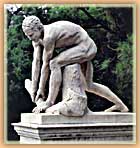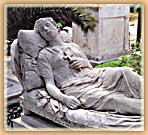 |

The sculpture of the 19th century, following the general artistic trends which prevailed at that time in Europe, adopted the teachings of neoclassicism, a trend which made Classical Antiquity a source of inspiration.
The intense building activity in Athens in the first decades following the transfer of the capital favoured the development of sculpture. Many sculpture workshops were created. These made mainly busts, which were in great demand.
The Greeks of the Diaspora who came to Athens in the last decades of the century, investing capital in the new kingdom, ordered sculptures and the successful participation in various international exhibitions shows the growing success of Greek sculpture in these years.
The development of neohellenic sculpture began in the Ionian Islands. In 1815 the Public Academy of Fine Arts was founded on Corfu by the sculptor Pavlos Prosalentis. Two more important sculptors from Corfu were Dimitrios Trivolis-Pierris and Ioannis Kalosgouros. In Athens, the first known sculptor of the post-revolutionary period was the Bavarian Christian Siegel, who also began teaching sculpture at the School of Arts in 1847.
As for the painters, the most significant in the Greek capital around the middle of the century were from Tinos, an island with an age-old tradition in marble sculpture. The father of the painter Nikiphoros Lytras, Antonios, a professional marble-sculptor who worked on the construction of the palaces, was one of the first popular sculptors. He was followed by the brothers Lazaros (1831-1909) and Georgios (1832-1900) Phytalis, also from Tinos. The latter became a professor of sculpture while one of his most significant works was the statue of Grigorios V at the propylaea of the University of Athens. Ioannis Kossos (1832-1878) created the statue of Evaggelos Zappas outside the Zappeio Megaron and that of Rigas Pheraios at the propylaea of the University. Other memorable sculptors of the period include Leonidas Drosis (1834-1882), Georgios Vroutsos (1843-1909) and Ioannis Vitsaris (1844-1892).
One of the most creative sculptors of the last decades of the 19th century is Dimitrios Philippotis (1839-1919). He, too, was from Tinos; he studied in the School of Arts and later in Rome. One of his best known works is the Xylothrafstis (Wood-chopper) which today stands opposite the Panathenian Stadium. This period is defined as the first artistic period of the work of Giannoulis Chalepas (1851-1938), also from Tinos. He studied in Athens and Munich. Until 1888, when he was hospitalized in a psychiatric clinic and ceased his sculpting activities, he made a small number of works which nevertheless show his natural talent with the Koimomeni (Sleeping Lady), a burial monument in the First Cemetery of Athens, as his best work.
|


 |